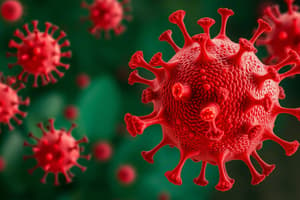Podcast
Questions and Answers
What type of hypersensitivity is characterized by an exaggerated response to anaphylactic stimuli?
What type of hypersensitivity is characterized by an exaggerated response to anaphylactic stimuli?
- Type 1 Hypersensitivity (correct)
- Type 4 Hypersensitivity
- Type 3 Hypersensitivity
- Type 2 Hypersensitivity
Which cells are primarily involved in the mechanism of Type I hypersensitivity reactions?
Which cells are primarily involved in the mechanism of Type I hypersensitivity reactions?
- Mast cells and basophils (correct)
- Platelets
- Neutrophils
- Eosinophils
In Type II hypersensitivity, antibodies bind to antigens found on which of the following?
In Type II hypersensitivity, antibodies bind to antigens found on which of the following?
- External antigens in the bloodstream
- Pathogen surfaces
- The patient's own cell surfaces (correct)
- Extracellular matrix components
What is the immediate phase duration for Type I hypersensitivity reactions post-exposure to an allergen?
What is the immediate phase duration for Type I hypersensitivity reactions post-exposure to an allergen?
Which of the following is NOT a clinical manifestation of Type I hypersensitivity?
Which of the following is NOT a clinical manifestation of Type I hypersensitivity?
What key role does IgE play in Type I hypersensitivity responses?
What key role does IgE play in Type I hypersensitivity responses?
Which of the following processes can suppress mast cell degranulation in the context of hypersensitivity reactions?
Which of the following processes can suppress mast cell degranulation in the context of hypersensitivity reactions?
Which type of hypersensitivity is characterized by immune complex formation?
Which type of hypersensitivity is characterized by immune complex formation?
What role do macrophages or dendritic cells play in the immune response described?
What role do macrophages or dendritic cells play in the immune response described?
In type 2 hypersensitivity, which antibodies are primarily involved in tagging cells for destruction?
In type 2 hypersensitivity, which antibodies are primarily involved in tagging cells for destruction?
Which of the following is NOT an example of type 3 hypersensitivity?
Which of the following is NOT an example of type 3 hypersensitivity?
What differentiates type 4 hypersensitivity from other types?
What differentiates type 4 hypersensitivity from other types?
What is a common symptom experienced by patients with rheumatoid arthritis in the morning?
What is a common symptom experienced by patients with rheumatoid arthritis in the morning?
Which mechanism is primarily responsible for cell destruction in antibody-dependent cell-mediated cytotoxicity?
Which mechanism is primarily responsible for cell destruction in antibody-dependent cell-mediated cytotoxicity?
Which cytokine is secreted by activated CD4+ T cells to stimulate further immune response in type 4 hypersensitivity?
Which cytokine is secreted by activated CD4+ T cells to stimulate further immune response in type 4 hypersensitivity?
Which of the following conditions features symptoms such as fever and lymphadenopathy due to immune complex formation?
Which of the following conditions features symptoms such as fever and lymphadenopathy due to immune complex formation?
What type of hypersensitivity is characterized by localized tissue injury due to immune complex deposition?
What type of hypersensitivity is characterized by localized tissue injury due to immune complex deposition?
Which chronic condition is likely responsible for extra-articular manifestations such as pericarditis and pleurisy?
Which chronic condition is likely responsible for extra-articular manifestations such as pericarditis and pleurisy?
The reaction to what drug demonstrates type 2 hypersensitivity through binding to red blood cells?
The reaction to what drug demonstrates type 2 hypersensitivity through binding to red blood cells?
Which antibody is NOT typically involved in forming immune complexes in type 3 hypersensitivity?
Which antibody is NOT typically involved in forming immune complexes in type 3 hypersensitivity?
Which condition is characterized by paroxysmal narrowing of the bronchial airways?
Which condition is characterized by paroxysmal narrowing of the bronchial airways?
Which of the following is a symptom of type 4 hypersensitivity and is often delayed in onset?
Which of the following is a symptom of type 4 hypersensitivity and is often delayed in onset?
Which of the following is NOT considered a common cause of acute asthma?
Which of the following is NOT considered a common cause of acute asthma?
What is indicated by the presence of subcutaneous nodules in a patient with ARF?
What is indicated by the presence of subcutaneous nodules in a patient with ARF?
What are the major criteria used for the diagnosis of ARF according to the Jones criteria?
What are the major criteria used for the diagnosis of ARF according to the Jones criteria?
In what age group is ARF most commonly reported?
In what age group is ARF most commonly reported?
Which treatment method is NOT part of the standard management for ARF?
Which treatment method is NOT part of the standard management for ARF?
Which finding is characteristic for rheumatic fever diagnosis yet not specific for ARF?
Which finding is characteristic for rheumatic fever diagnosis yet not specific for ARF?
What is the role of steroids in the treatment of ARF?
What is the role of steroids in the treatment of ARF?
Which symptom is least associated with the acute presentation of ARF?
Which symptom is least associated with the acute presentation of ARF?
What can precipitate asthma symptoms specifically in women?
What can precipitate asthma symptoms specifically in women?
Which of the following is a characteristic of streptococcal infection in relation to ARF?
Which of the following is a characteristic of streptococcal infection in relation to ARF?
Which of the following laboratory findings is NOT part of the minor criteria for ARF diagnosis?
Which of the following laboratory findings is NOT part of the minor criteria for ARF diagnosis?
Which condition occurs in about 5% of ARF cases and is characterized by rapid, purposeless movements?
Which condition occurs in about 5% of ARF cases and is characterized by rapid, purposeless movements?
Which term describes the nodule formation seen in ARF and typically occurs on extensor surfaces?
Which term describes the nodule formation seen in ARF and typically occurs on extensor surfaces?
The introduction of antibiotics for treating which infection significantly reduced the incidence of rheumatic fever?
The introduction of antibiotics for treating which infection significantly reduced the incidence of rheumatic fever?
Flashcards
Type 1 Hypersensitivity
Type 1 Hypersensitivity
An exaggerated immune response, often triggered by an allergen. It involves the release of chemicals (histamine) from mast cells and basophils, leading to rapid reactions such as hives, itching, and swelling.
Type 2 Hypersensitivity
Type 2 Hypersensitivity
Antibodies produced by the immune system bind to antigens on the patient's own cell surfaces.
Type 3 Hypersensitivity
Type 3 Hypersensitivity
Immune complexes (antibody-antigen combinations) deposit in various tissues, activating complement and causing inflammation.
Type 4 Hypersensitivity
Type 4 Hypersensitivity
Signup and view all the flashcards
Mast Cells and Basophils
Mast Cells and Basophils
Signup and view all the flashcards
IgE
IgE
Signup and view all the flashcards
Mast Cell Degranulation
Mast Cell Degranulation
Signup and view all the flashcards
Allergens
Allergens
Signup and view all the flashcards
Intrinsic Antigen
Intrinsic Antigen
Signup and view all the flashcards
Extrinsic Antigen
Extrinsic Antigen
Signup and view all the flashcards
Type 2 Hypersensitivity (Antibody-Dependent)
Type 2 Hypersensitivity (Antibody-Dependent)
Signup and view all the flashcards
Penicillin Allergy
Penicillin Allergy
Signup and view all the flashcards
Antigen Presenting Cells (APCs)
Antigen Presenting Cells (APCs)
Signup and view all the flashcards
Type 3 Hypersensitivity (Immune Complex)
Type 3 Hypersensitivity (Immune Complex)
Signup and view all the flashcards
Arthus Reaction
Arthus Reaction
Signup and view all the flashcards
Serum Sickness
Serum Sickness
Signup and view all the flashcards
Type 4 Hypersensitivity (Delayed Type)
Type 4 Hypersensitivity (Delayed Type)
Signup and view all the flashcards
Rheumatoid Arthritis (RA)
Rheumatoid Arthritis (RA)
Signup and view all the flashcards
Felty's Syndrome
Felty's Syndrome
Signup and view all the flashcards
Sjogren's Syndrome
Sjogren's Syndrome
Signup and view all the flashcards
Asthma
Asthma
Signup and view all the flashcards
Cytokine
Cytokine
Signup and view all the flashcards
Cytotoxic T Cell (CD8+)
Cytotoxic T Cell (CD8+)
Signup and view all the flashcards
Helper T Cell (CD4+)
Helper T Cell (CD4+)
Signup and view all the flashcards
Prostaglandins
Prostaglandins
Signup and view all the flashcards
Thromboxanes
Thromboxanes
Signup and view all the flashcards
Prostacyclins
Prostacyclins
Signup and view all the flashcards
Leukotrienes
Leukotrienes
Signup and view all the flashcards
Rheumatic Fever (RF)
Rheumatic Fever (RF)
Signup and view all the flashcards
Exudative and Proliferative Inflammation
Exudative and Proliferative Inflammation
Signup and view all the flashcards
Connective Tissue Inflammation
Connective Tissue Inflammation
Signup and view all the flashcards
Migratory Polyarthritis
Migratory Polyarthritis
Signup and view all the flashcards
Subcutaneous Nodules (Aschoff Bodies)
Subcutaneous Nodules (Aschoff Bodies)
Signup and view all the flashcards
Erythema Marginatum
Erythema Marginatum
Signup and view all the flashcards
Chorea (Sydenham Chorea)
Chorea (Sydenham Chorea)
Signup and view all the flashcards
Jones Criteria
Jones Criteria
Signup and view all the flashcards
Penicillin
Penicillin
Signup and view all the flashcards
Prophylaxis
Prophylaxis
Signup and view all the flashcards
Study Notes
Hypersensitivity Overview
- Hypersensitivity is an exaggerated immune response to antigens, potentially causing pathological reactions, either to foreign antigens or self-tissue.
- Four categories classify hypersensitivity reactions. Some reactions involving antibody-antigen complexes are further categorized.
Type I Hypersensitivity (Immediate/Anaphylactic Hypersensitivity)
- Characterized by a rapid immune response (15-30 minutes).
- Late-phase reaction (10-12 hours) also possible.
- Affects various systems: skin (urticaria, eczema), eyes (conjunctivitis), nasopharynx (rhinorrhea, rhinitis), bronchopulmonary (asthma), and gastrointestinal tract (gastroenteritis).
- Range of effects: from mild discomfort to death.
- Mast cells/basophils are the primary immune cells. Platelets, neutrophils, and eosinophils also affect the process.
- Triggered by IgE binding to allergens on mast cells and basophils.
- Subsequent allergen exposure cross-links IgE, releasing pharmacologically active substances.
- Mast cell degranulation depends on intracellular calcium flux.
Type II Hypersensitivity (Antibody-Dependent)
- Antibodies target self-cell surfaces.
- Antigens can be intrinsic (part of the patient's cells) or extrinsic (absorbed onto cells).
- Macrophages/dendritic cells process the antigen, triggering B-cell response.
- Antibodies (IgG, IgM) form complexes.
- Complement system activation occurs, causing cell lysis/death.
- Antibody-dependent cell-mediated cytotoxicity (ADCC) involves NK cells and macrophages targeting antibody-tagged cells for phagocytosis.
- Reaction time: hours to a day.
- Examples include hemolytic anemia, rheumatic fever, and systemic lupus erythematosus (SLE).
Type III Hypersensitivity (Immune Complex)
- Soluble immune complexes (antigen-antibody aggregates) form and deposit in tissues (skin, kidney, joints), eliciting an immune response through the complement system.
- Reaction time: hours to days.
- Two types:
- Arthus reaction (localized): Inflammation at specific sites (e.g., hemorrhagic vasculitis and edema).
- Serum sickness (systemic): Inflammation spreads throughout blood and tissues (fever, splenomegaly, lymphadenopathy, arthralgia, urticaria).
- Examples: Immune complex glomerulonephritis, rheumatoid arthritis (post-GABHS infection), subacute bacterial endocarditis, malaria symptoms, hydralazine-induced SLE.
Type IV Hypersensitivity (Cell-Mediated/Delayed-Type Hypersensitivity)
- A cell-mediated, not antibody-mediated, response.
- Reaction develops over two to three days.
- CD8+ cytotoxic T cells and CD4+ helper T cells recognize antigen-MHC complexes.
- Antigen-presenting cells (APCs) are macrophages which produce IL-1. IL-1 stimulates further CD4+ T cell proliferation.
- CD4+ T cells produce IL-2 and interferon-gamma (IFN-γ), promoting the release of Type 1 cytokines.
- Activated CD8+ T cells directly destroy target cells.
- Activated macrophages produce hydrolytic enzymes and can form multinucleated giant cells.
- Examples: Contact dermatitis (e.g., poison ivy), temporal arteritis, leprosy symptoms, tuberculosis symptoms, transplant rejection, celiac disease.
Rheumatoid Arthritis (RA)
- A chronic inflammatory, systemic disease affecting multiple body systems.
- Significant work disability in 60% of patients within ten years of disease onset.
- Characterized by polyarthritis (symmetrical joint inflammation), morning stiffness lasting over an hour, and improvement in pain with use of the joints.
- Extra-articular manifestations distinguish RA from osteoarthritis, including anemia (possibly from GI bleeding), hepatosplenomegaly with leukopenia (Felty's syndrome), and lymphocytic infiltration of salivary/lacrimal glands (Sjögren's syndrome).
- Other features: Pericarditis, pleurisy, alveolitis, scleritis, subcutaneous nodules.
- Etiology is unknown, but likely involves autoimmune response (immune system mistakenly targeting self-proteins).
Asthma
- Characterized by paroxysmal narrowing of bronchial airways due to inflammation of bronchi and smooth muscle contraction.
- Inflammation is central to symptoms (dyspnea, cough, wheezing).
- Antigen-antibody interactions (e.g., allergen exposure) initiate a cascade: membrane phospholipase activation leads to arachidonic acid production.
- Arachidonic acid metabolism produces vasoactive prostaglandins and leukotrienes (potent smooth muscle constrictors triggering airway hyperresponsiveness and inflammation).
- Causes include viral infections, allergens, smoke, cold/dry air, and potentially menstrual cycle fluctuations in women.
Rheumatic Fever (RF)
- A serious complication of group A streptococcal infections (usually upper respiratory tract).
- Marked inflammatory response affecting multiple systems (heart, joints, CNS, skin).
- Occurs primarily in school-aged children during periods of high streptococcal infection prevalence (e.g., colder months).
- Two patterns of presentation:
- Sudden onset: polyarthritis, fever, toxicity, 2-6 weeks after infection.
- Insidious or subclinical: mild carditis develops gradually.
- Diagnosed using Jones criteria (major criteria: carditis, migratory polyarthritis, subcutaneous nodules, erythema marginatum, Sydenham chorea; minor criteria: arthralgia, fever, elevated acute-phase reactants, positive streptococcal tests, prolonged PR interval.
Treatment & Prognosis:
- RF: Treatment focuses on treating streptococcal infection with antibiotics (benzathine penicillin G, penicillin V, or erythromycin), pain/inflammation management with steroids/salicylates, and heart failure management with digitalis, plus long-term prophylaxis for recurrent streptococcal infections.
- RF: Prognosis depends on the severity of acute heart involvement. Complications include carditis, mitral stenosis, and congestive heart failure.
Studying That Suits You
Use AI to generate personalized quizzes and flashcards to suit your learning preferences.




